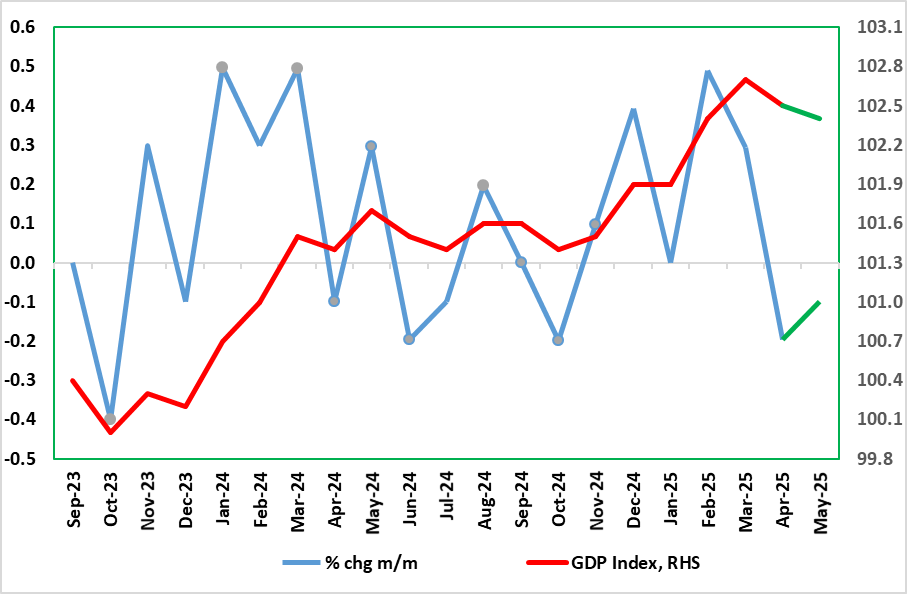UK GDP Review: Another Downside Surprise
After two successive upside surprises, a correction back in monthly GDP was not entirely a wholesale surprise for April GDP. But that 0.3% m/m drop was almost repeated in the May numbers (Figure 1), where a further albeit smaller (ie 0.1%) fall occurred, but very much below consensus. Admittedly there were some upward revisions to data before April, which have created base effects that may (now) prevent Q2 seeing a q/q fall. Regardless, especially given private sector softness, the latest GDP outcomes thereby add to a gloomier economic backdrop most recently highlighted by growing signs of labor market weakness. As a result, we think that Q2 GDP will be flat in q/q terms and may be as weak in Q3, the former undershooting BoE thinking of a rise of around 0.25%. The weakness we envisage chimes with business surveys, payrolls and tax outcomes. If this pattern persists (let alone if it is even worse, then the BoE’s relative complacency regarding the economy is likely to shift and possibly rapidly.
Figure 1: GDP Falls Again?

Source: ONS, CE
Indeed, it seems even more to be the case that Q1 numbers may have been boosted by added production destined for the U.S in anticipation of tariffs, this evident in an industry reported slump in car production for the month of some 25% m/m (ie enough to knock GDP by 0.2 ppt itself. In addition, real estate activity seems to have dropped after the raising of effective stamp duty. Moreover, we already know that retail sales dropped clearly in May, this alone also potentially knocking m/m GDP down by over 0.2 ppt. Against this backdrop, the May GDP numbers could have been much worse and would have been had it not been for some fresh rises in public services, without which the May drop would have been twice as large and where recent GDP rises would have been minimal!
Perhaps more notably and something policy makers should bear in mind, the data volatility of late suggest what may be changing seasonal factors post pandemic which may mean the UK economy in early 2025 is seeing similar but short-lived strong growth as seen in in the same period of last year – thus any solid Q1 gain needs to be put into that perspective. But even amid a BoE view of near zero growth underlying envisaged this quarter, we think the Bank is too optimistic about both the current state of the economy and the medium-term outlook, not least as it as its 1.5% average consumer spending forecast for 2025-26 does not seem to have taken any toll from the higher inflation it has pointed to. And of course there is the global trade uncertainty which is going to hit continental Europe possible a protracted basis, now likely to be accentuated by what may be significant fiscal tightening into 2026 as tax rises loom to repair a widening fiscal hole.
Against this backdrop, it not surprising how payroll and business surveys are now flagging a slumping activity outlook. Admittedly, PMI survey numbers are less downbeat than numbers emanating from the CBI, whose survey numbers are somewhat more broad-based than the former’s high-profile composite index. But the PMI also tell a weaker story once its construction survey is included! With this in mind, we envisage zero growth in both Q2 and Q3 GDP and only around 0.9% for the whole of 2025 and maybe weaker for 2026. At this juncture, next year actually sees a better underlying tone but this could prove optimistic given the likely fiscal tightening alluded to above.